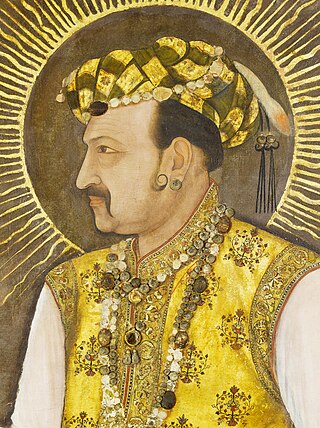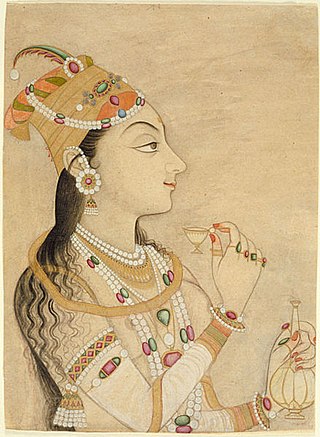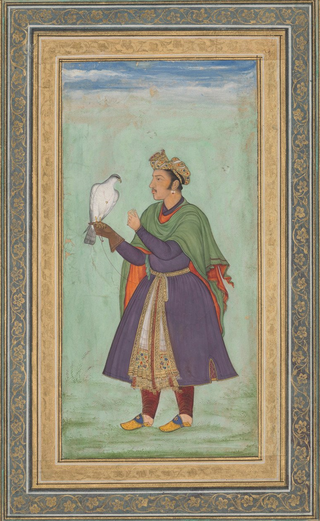Related Research Articles

Nur-ud-Din Muhammad Salim, known by his imperial name Jahangir, was the fourth Mughal Emperor, who ruled from 1605 till his death in 1627.

Mirza Shahab-ud-Din Muhammad Khurram, also known as Shah Jahan I, was the fifth Mughal Emperor, reigning from 1628 until 1658. During his reign, the Mughals reached the peak of their architectural and cultural achievements.

Nur Jahan, born Mehr-un-Nissa was the twentieth wife and chief consort of the Mughal emperor Jahangir.

Mirza Shah Shuja was the second son of the Mughal Emperor Shah Jahan and Empress Mumtaz Mahal. He was the governor of Bengal and Odisha and had his capital at Dhaka, in present day Bangladesh.
Mihr-un-nissa Begum, also known as Banu Begum and Bahu Begum, and better known as Ladli Begum, was the daughter of Empress Nur Jahan and her first husband Sher Afgan of the Mughal Empire. She was the wife of Prince Shahryar Mirza, son of Emperor Jahangir.

Shahryar Mirza was the fifth and youngest son of the Mughal emperor Jahangir. At the end of Jahangir's life and after his death, Shahryar made an attempt to become emperor, planning, supported and conspiracy by his one in influence and all-powerful stepmother Nur Jahan, who was also his mother-in-law. The succession was contested, though Shahryar exercised power, based in Lahore, from 7 November 1627 to 19 January 1628, but like his father, he allowed Nur Jahan to run the affairs and consolidate his reign, but she did not succeed, and he was defeated and was killed at the orders of his brother Khurram, better known as Shah Jahan once he took the throne. Shahryar would have been the fifth Mughal Emperor, but is usually not counted in the list of Mughal Emperors.

Khusrau Mirza was the eldest son of the Mughal Emperor Jahangir and his first wife, Shah Begum. The young prince displayed exceptional skills and wisdom and had the privilege to be groomed by the Mughal Emperor (Akbar) himself for the throne of the Mughal Empire. He turned out to be the most capable and qualified son of Jahangir but was befallen by an unfortunate destiny. Being Jahangir's eldest son, he was the heir-apparent to his father but Jahangir favoured his son Khurram Mirza as he held an animosity against Khusrau.
Begum is a female title which is also used in Mirza families/lineages, Daughter of Beg or Wife of Beg, a given name and surname.

Abu'l-Hasan entitled by the Mughal emperor Jahangir as Asaf Khan, was the Grand Vizier of the fifth Mughal emperor Shah Jahan. He previously served as the vakil of Jahangir. Asaf Khan is perhaps best known for being the father of Arjumand Banu Begum, the chief consort of Shah Jahan and the older brother of Empress Nur Jahan, the chief consort of Jahangir.

Manavati Bai, also spelled Manvati Bai,, better known by her title, Jagat Gosain, was the second wife and the empress consort of the fourth Mughal emperor Jahangir and the mother of his successor, Shah Jahan.

Parviz Mirza was the second son of Mughal emperor Jahangir from his wife, Sahib Jamal. His daughter, Nadira Banu Begum, later became the wife of Dara Shikoh.

Padshah Begum was a superlative imperial title conferred upon the empress consort or 'First Lady' of the Mughal Empire and was considered to be the most important title in the Mughal harem or zenana. This title can be equivalent with "empress" in English, but in only approximate terms in the Mughal context.
Bakshi Banu Begum was a Mughal princess and was the second daughter of Emperor Humayun and his consort Gunwar Bibi. Bakshi Banu was thus the older half-sister of the Mughal Emperor Akbar.
Siyaasat is a 2014 Indian fictional drama which aired on The EPIC Channel. The series is an adaptation of the popular 2002 award-winning fictional novel The Twentieth Wife by author Indu Sundaresan.
Izz-un-Nissa Begum was the third wife of the Mughal emperor Shah Jahan. She is popularly known by the title, Akbarabadi Mahal, and commissioned the Akbarabadi Mosque in Shahjahanabad. Less commonly, she is also referred to as Sirhindi Begum.

Khas Mahal, meaning "The exquisite one of the palace", was one of the chief wives of the Mughal emperor Jahangir.
Bahar Banu Begum, meaning "The Blooming Lady", was a Mughal princess, the daughter of Mughal emperor Jahangir.
Sakina Banu Begum was a Mughal princess, the daughter of Mughal emperor Humayun.
Hoshmand Banu Begum, meaning "The Prudent Lady", was a Mughal princess, the daughter of Prince Khusrau Mirza, and the granddaughter of Mughal emperor Jahangir.
Shakr-un-Nissa Begum, also Shakr al-Nisa Begum was a Mughal princess, the daughter of Emperor Akbar.
References
- 1 2 3 4 Findly, Ellison Banks (1993). Nur Jahan, empress of Mughal India . New York: Oxford University Press. p. 125. ISBN 9780195360608.
- ↑ The Journal of the Numismatic Society of India, Volumes 20-21. Numismatic Society of India. 1958. p. 196.
- ↑ Lal, K.S. (1988). The Mughal harem. New Delhi: Aditya Prakashan. p. 27. ISBN 9788185179032.
- ↑ Abdul Kader, M. (1988). Historical Fallacies Unveiled. İslamic Foundation Bangladesh. p. 105.
- 1 2 Sharma, Sudha (March 21, 2016). The Status of Muslim Women in Medieval India. SAGE Publications India. pp. 144, 209. ISBN 978-9-351-50567-9.
- ↑ Asiatic Society (Calcutta, India) (1 January 1932). "Journal and Proceedings of the Asiatic Society of Bengal". 25. Asiatic Society.: 62.
{{cite journal}}: Cite journal requires|journal=(help) - ↑ Foster, Sir William (1975). Early travels in India, 1583-1619. AMS Press. pp. 100–101. ISBN 978-0-404-54825-4.
- ↑ Jahangir, Emperor; Thackston, Wheeler McIntosh (1999). The Jahangirnama : memoirs of Jahangir, Emperor of India. Freer Gallery of Art and Arthur M. Sackler Gallery, Smithsonian Institution; New York: Oxford University Press. pp. 340. ISBN 978-0-19-512718-8.